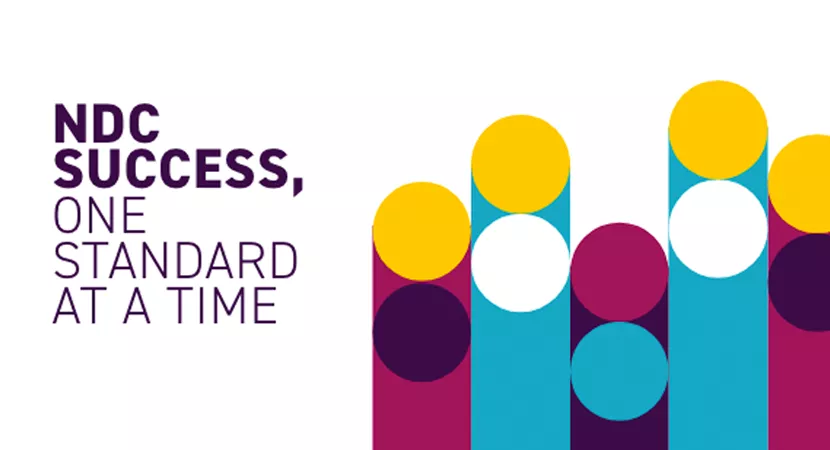On demand | Elevate 2022
Distribution: Ready to play?
INTERVIEW • DISTRIBUTION
The distribution gameboard continues to change. New players, new technologies, and new traveler profiles are changing the way airlines deliver their differentiated products to market. What future scenarios are most likely to play out and why? What effect will they have on us?
Put on your game-theory hat for this fun, informational session where we explore airline distribution's current and future state.
Cory: Oh, thank you for that rousing applause.
Graham: That was amazing.
Cory: Yeah.
Graham: Yeah. Thanks so much for having us back. Happy to be back, this time not with a Canadian, but Cory's a good old friend of mine and we're going to try to do something fun today.
We've been talking a lot about dynamic pricing and a lot of other topics, and airlines are forging ahead, making changes, producing great offers. The trick is getting those things to the marketplace.
So we're here to talk about distribution and really what's next. So we're going to do something different today. We're going to do a little game. So all of us, Cory, I, and all of you, hopefully will participate in this game. We're going to have three questions around distribution and change and what's coming in the next three to five years. So then we're going to talk about it. Debate. Hopefully you guys will weigh in. We're going have microphones in the back so you can talk, you're going to be able to vote, and we'll look at the results.
Cory: We’ll be calling people out by name as well, right?
Graham: I think we should.
Cory: Yeah.
Graham: So hands-on session. You see there, the Slido prompt slide. You can either scan the barcode or log into slido.com #ATPCO and get ready to play. So if you're all ready, we'll go to the first topic. So our first topic is dynamic pricing. You just saw a panel this morning first kickoff around dynamic pricing and Tom did a great job of showing us that or a derivative of that graphic.
So our first question is really around this graphic and how we think the needle will move. Clocks going up, not down. So here we go. Question number one, get your Slido already. I'll read the question for you guys. So in five years, which of the following offer types will be most widely used? So there's your four choices. Traditional, so that's really what we have today, published private fares priced with dynamic availability. The second choice then, the next three are really dynamic but just different variations of the theme up the graphic. So personalized ancillaries and/or bundles, dynamic fares discounted from a published price point, or dynamic fare priced without reference to published price points.
And the votes are coming in. It's looking tied at the top there. It's good. So we're going to get the house lights up a little bit. We got some microphones. Love to hear from you guys around why you think fares discounted from published price points is probably the leader right now. While we're waiting for that, do you agree with that, Cory?
Cory: It feels realistic to me, honestly. I'm kind of notoriously horrible at making forecasts on distribution change, which I think is why I've been involved in distribution change for so long. So it's like the carrot that's kind of hanging out over the dog, the dog is constantly running for but never quite making. To me that kind of feels reasonable because change always happens. Always takes about twice as long as I expect, and when it happens, it's about half as much as I thought it was going to be.
So it does feel reasonable that the option that kind of hangs off a lot of the traditional architecture, but makes improvements upon that. That seems to make a bit more sense to me. A show of hands. Which one of you would be bold enough to raise your hand and say that you voted for that first option there? Fares discounted from published price points. There's a lot. Can we get a anybody willing to make a comment? Actually, I see Mat Orrego over there. Let's get a microphone over to Mat Orrego, Cornerstone Information Systems. Mat, tell us why you voted for that.
Mat: Well, I just think it's realistic just given how the operations of the industry work today. That huge dependency on the operations of district reliance on distribution as it is defined today. Things change in time. I don't think we've reached a tipping point that defines it one way or the other yet. And I think that's what you're seeing right there. Perhaps some optimism, I'm just more of a realist and if you ask the question in five years, where do I see it? I don't see it today yet. You've been around long enough to hear a lot of conversations about significant changes in distribution and technology. So I guess you've seen this story before. It is. it's going to evolve, eventually, it will be because the problem is real. You know how the products are defined today, how airline products are defined today need to change. But fundamentally, I mean one of the things that also needs to change is how retailing is done. You look at traditional retailing or retailing in the world today. You have great stores that define a retail experience. Do you have a great airline that is commensurate with a great retail experience too and booking paths and the way to shop? It's not just about the offer, it's the entire package that needs to change as well.
Cory: All right, thanks Mat. Anybody vote for that second option? The personalized ancillaries and/ or bundles I want to hear any hands up. Watch, they won't raise their hands anymore because I called on one of them.
Graham: I wanted to see the traditional one though that surprises me that one in five people still think, that's kind of bucking the trend. All the projections are like what you guys are saying and you're saying that likely we're not going to get to the target we want to in terms of no fare basis, but we're going to be doing dynamic. So that's kind of the trend that we're seeing. It's one in five people here think that's not going to happen. Yeah, right. Love to hear anybody brave enough to tell us who voted for traditional and why. Why do you think that's the case?
Cory: In the middle here? We can't see a thing. Oh, it's Jeff Klee of Amtrav.
Jeff: Sorry, I didn't vote for that. I voted for the personalized ancillaries and bundles.
Cory: OK, tell us why, tell us why. Yeah.
Jeff: It might be wishful thinking, but I think that all the others are kind of fraught with problems and that the only variable is the price. And I don't know that I see a world where every single customer gets a different price for the exact same product, but what I think should be the prize is the idea of true bundling, where every corporation can have a negotiated bundle that fits their needs and that they're getting an offer that, it's not just about a different price on the same offer, but it's a genuinely different offer with a different set of products. And I think if we could reach that point, we will have accomplished a lot.
Graham: So that's more like what we heard from Air Canada yesterday, on their direction on where they're going.
Cory: Yeah, either one of these two options is a big change, from an industry perspective, because it means where the shopping is occurring is shifting from third party systems to airline systems. That's a massive paradigm shift and what we're seeing, so far at least, is whereas it may be comparatively easier for GDSs and airlines to sign up to a new NDC deal, it seems to be much harder to actually make those NDC connections come to life, at least so far. I think maybe we'll transition to the next topic.
To segue to the next topic, I'll just share with you a data point that T2RL has on this question of dynamic pricing. Tom Gregorson mentioned a study that T2RL did. 29 of the top airlines told T2RL in May of this year what their plans are in terms of dynamic pricing, and what came out in that study was that 83% of those 29 airlines plan on implementing dynamic pricing of some form in their direct and or indirect channel sometime in the next two years. 83%. And I was shocked by that number. I was aware that many airlines were thinking about it. I never would have guessed that it would be 83% that are actually thinking about it. But it does make a tremendous amount of sense that, especially in markets where you're an airline that overlaps with ultra low cost carriers or something like that, who by their very nature price dynamically, you have to have your direct and indirect channels equipped with price points that make you competitive.
So I guess I shouldn't have been surprised in retrospect, but what that means is, if an airline is dynamically pricing the price of a flight from point A to point B, then the shopping results need to come from the airline system that calculates that price. And for the most part, that means NDC connections need to not only be agreed with GDSs and aggregators and agencies, but actually implemented in real life. And so far, according to T2RL’s numbers, about 4% of global PBs are processed by NDC. Almost all of those are through aggregators or true direct connects. And almost all of that is in the leisure space.
And that's where we transition to this topic. So this topic really talks about how corporate distribution channels may evolve over the next few years. And this growing content gap that T2RL at least sees happening now, is what we think is going to be the major driving force, if any, a driving change in this segment of the market. And so let's talk about how this part of the market is evolving.
First of all, T2RL is speaking in its new lines of business, is speaking more and more with corporate travel managers themselves and some of the biggest and most sophisticated corporate travel managers are telling us that they're actually starting to notice price differences between the existing incumbent corporate channels. So think of that as the big TMCs and the GDSs together as one package. So they're seeing a content gap between the big TMCs and the GDSs versus what their travelers are seeing in other channels. And increasingly, corporate travel managers are telling us that they suspect that that has something to do with dynamic price points that are being put in the market. So that's something that's been more common in Europe. But now you know, United for example has been more public about some of the experimentation that they're doing in the US market, which I thought was really notable just from a game theory perspective.
Graham: Are they concerned with off- policy booking? Going around?
Cory: I don't know if they're concerned about it. I think the issue is they're concerned that the TMC/GDS tech stack may be falling short to some degree. So to the extent that this is becoming a technology issue and not a commercial issue anymore. They have to worry not whether the TMC or the GDS can actually secure the agreements for that content. They have to worry whether those channels are going to be able to keep up.
Graham: And they still have their obligations to the corporation to fill. So they're stuck.
Cory: Yeah, exactly. And if 83% of airlines really are going to have dynamic price points in the market in two years, how fast are the NDC implementations going to go now as compared to how fast they've gone to this point? So I think some reasonable people have come to the conclusion that at least it needs to diversify. And so the corporate travel managers that find themselves in this situation, they're kind of comparing the existing incumbent corporate channels to what we think of as these emerging corporate channels.
And the emerging corporate channels can take different flavors. One flavor is, it's just a TMC that's using a different tech platform that maybe keeps up a bit better. So think Flight Centre and TPConnects. Or it's one of the new tech platforms players like a Spotnana. A different flavor is the corporate traveler going directly to the airline’s website to get access to those shopping results. So that could be facilitated by a Blockskye or a Winding Tree or New Travel or somebody like that. And so we've got this kind of juxtaposition. We've got the existing incumbent channels, which are well established today and have had primarily an unassailable position at this point. And then we have these emerging corporate channels.
So that brings us to the next question, topic two. Over the next three to five years, how will new and emerging corporate channels impact existing corporate channel market share? So how much will the emerging corporate channels eat away from the existing channels? Do you think it will be minimal to no impact, so the existing or incumbent channels will maintain or grow their share? Do you think it will be a moderate impact where they'll take maybe 20% from the existing channels, or will they be a major impact 40% or more?
It's looking pretty moderate Impact, that feels like a good happy medium, right? Yeah, 20% would be a lot, for sure would be a lot considering how little change has happened in this segment of the market in particular. All right. So anybody want to raise their hand and talk about the moderate impact? This is where I get to start calling on names. I know so many names in this room. And I'm actually very curious about what some of them think about this. Come on, somebody. I'm going to go back to Jeff Klee on this one. Jeff chimed in early on the earlier question, but I'm actually very curious about what Jeff thinks about some of the emerging channels and whether material progress can be made in the corporate space.
Jeff: I mean, I voted for major impact that's why I didn't raise my hand. So I agree with your premise completely. I think the only wild card is do the incumbent channels adopt to fend off the emerging channels, because I don't think the status quo is sustainable. I think the content fragmentation is becoming too severe. So everyone, if you're in the corporate travel business needs a strategy of how to get content. If that strategy is to rely on the GDSs, I think you've got a very challenging future.
Cory: So when you say, when you voted for major impact, did you assume that some of the existing TMCs that have historically been more GDS loyal will actually change their tech stacks to become less GDS loyal, or do you think the major impact comes from volume coming out of the existing channels and moving towards new channels?
Jeff: I think a lot of volume starts to leak out of the incumbent channels. Then the question is do they stop the bleeding by adopting? I mean right now, I don't see a ton of serious efforts on some of those incumbent channels to actually, they're fighting to preserve the status quo, not to adopt to the new reality. So will they change? Who knows. But I think that will determine if we end up in the moderate impact or the major impact categories here.
Cory: Okay. Anybody have a comment on the minimal impact? I mean I have a comment on that case I mean. Getting back to what I said earlier, I have historically underestimated or way overestimated the amount of change that could happen so fast and the commercial interests are so strong in this space for things to remain as they are.
Graham: Yeah.
Cory: The GDSs on average are making $2.00 per segment EBITDA. And you know, we think a competitive price point looks something more like $0.50 a segment. And so if I were a GDS, I wouldn't be rushing to change my business model. And you know, having TMC loyalty is a big part of keeping the business model just as it is. And so the commercial interests are so strong to keep everything exactly the way they are. I think the wild card is if dynamic pricing really takes off and there is a bigger and bigger content gap, and volume starts spilling out of the channel, do GDSs start losing volume at a rate that makes the TMCs uncomfortable? GDSs may be willing to lose more volume than a TMC may be willing to lose.
Graham: Right, kind of speaks to airline corporate contracts, right? Are these now going to have dynamic components to them? And if they do, how do they chase them?
Cory: Yeah, yeah. All right, next topic, final topic, number three. ONE Order. I'll start this with a story, and my American Airlines colleagues in the room will laugh.
Coming back to the business case for ONE Order. Industry shopping systems have gotten to the point where easy is not a word I use lightly, so nothing is really easy, but it's comparatively easier to add a product in your merchandising catalog and do some creative things with pricing than it is to actually deliver that product. And it's crazy. There was, I recall, a product in my old world that we were trying to implement. And that product would have taken maybe a couple weeks to put in the merchandising catalog and get it set up to price the way that we wanted. But when we were mapping out how we'd actually implement the product in the PSS and then the delivery system, so that customers would actually receive it when they boarded the airplane, we found that it was crazy and very hairy, and so we were looking at using an SSR and a PNR, for those of you who know what an SSR is. And we're like, OK, we'll just create an SSR for this and we're like, okay, how much time and how much money will it cost to create an SSR and it was like 18 to 24 months or some garbage like that and just like this can't be. And so we're like okay, well, can we use an existing SSR that's not being used. And so we found one that wasn't being used. And so we used that one in the project, you know, was much shorter, but we had to do regression testing.
Graham: To make sure.
Cory: And when we did regression testing, we found that that SSR was actually still being used in some cases. And so that's total insanity. And we've reached a point where the shopping systems have gotten so far out that they're outstripping the capabilities of the order and the delivery systems to actually keep up with. And so airlines are leaving revenue on the table because they're not able to go as fast as they need to go on the order side. And so that's the business case for ONE Order.
In my view, the way the way ONE Order is going to evolve is probably slowly and it'll probably, you'll look at some big players like Lufthansa who's very committed to this path, that came out recently saying that they they're trying to get to 100% ONE Order by 2030, hopefully faster than that. We're lucky to count them as a client in order to help them source that platform. So you'll see some big guys like that. I'm sure you'll see some of their partners want to come along at some point as well because they'll see the writing on the wall that ONE Order is coming at least to their alliance.
And when the natural PSS expiries come up, you'll probably see those airlines get serious about their ONE Order strategy and then you might have kind of a long tail of others. There may be some startups out there like a Flyr in Norway which is famously implemented a 100% order-based system already. When you're a startup with 12 aircraft, that's comparatively easier to do versus starting from a legacy construct. And so it'll go in fits and starts in my opinion, but let's get the opinion of the audience.
How long do you think it will take for ONE Order systems to process more than 10% of industry orders? So let's keep this simple. Let's not say 100%, let's say 10%. Will it take 10 years, 3 years, 5 years, or it will never happen?
Graham: Well, at least that's not getting voted for.
Cory: If you say it will never happen, then Richard and I are going to go talk to your CEO and tell you you're crackers, in Richard speak. 10 years, 5 years, 3 years.
Graham: 10 years is a long time.
Cory: You know, to be fair, the NDC standard was codified 10 years ago, That's true. And we're not at 10% at an industry level. 10 years is feeling pretty reasonable.
Graham: This feels a little harder too.
Cory: I want to hear somebody who said three years. I didn't know that Lufthansa was in the room. Does anybody say three years? I'm just curious… That you again, Jeff? They're hiding from us, Graham. Okay, ten years. It's the popular answer. You're in the majority. You have no risk to say something about this. Who thinks it's going to be 10 years that hasn't already spoken.
Graham: It's a shy audience. Not a hand.
Cory: What do you think, Graham, is it going to be 10 years?
Graham: I hope not, no, but you know, that's a conservative view. I think there's a lot to do. And I think there's carriers like Air Canada yesterday they're not thinking about it yet. They know, they're not saying never, but they're a big airline, they're pretty progressive carrier, they've done a lot of stuff. So it's somewhere between 5 and 10 probably. I like 5. But I don't know, 5 goes quick, right?
Cory: I think about it this way, the average PSS agreement is, what, 10 to 15 years in length, which means on average 8 to 12% of the airline industry's PSS deals are coming up for renewal. And then what percentage of those 8 to 12% are thinking ONE Order is inevitable anyway? I would be not managing my business very well if I just sign up for the old product again. So I've got to imagine that some percentage of the industry will be moving forward.
Graham: So the wild card is the PSS response too. The incumbent PSS. What are they going to do about ONE Order and that could move the needle.
Cory: Yeah. All right. Well they're about to kick us off the stage here. I guess I would just kind of wrap up that what seems to be the feeling of the room is there's lots to be done. The industry is moving forward. The industry will move forward, perhaps slower than what we all hope, but perhaps at least in a productive direction.
Thanks to all of you who participated, thanks for your feedback on Slido and hope you enjoy the rest of the day.
An event experience you can't miss
ATPCO's Elevate + ARC's TravelConnect
Speakers

Cory Garner
Co-CEO, T2RL
Cory is a leading travel technology innovator and 20-year veteran of American Airlines, where he led American’s strategies for distribution, travel agency incentives, and programs for corporate customers of all sizes. He has been instrumental in driving global adoption of technologies that open new possibilities and economic streams for travel companies. Cory was a pioneer in the airline distribution technology which was later codified by IATA as its New Distribution Capability (NDC) standard. In part because of his strategic work, consumers can more easily compare airline products and airlines have access to a new, significant competitor to global distribution systems.

Graham Wareham
Director, Business Development and Partnerships , ATPCO
Graham has over 20 years of experience in the airline industry, including more than five years with ATPCO. His most recent experience as an aviation executive included strategic development, cost/revenue management, and market analysis. Before joining ATPCO, Graham worked as a Senior Director, Distribution and Consumer Direct for Air Canada. In his current role, Graham leads ATPCO's Business Development and Industry team, developing strategic business partnerships and relationships that will help to evolve standards and solutions that help solve evolving industry issues.
You might also like



